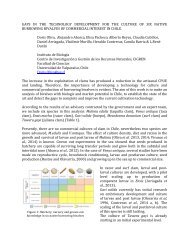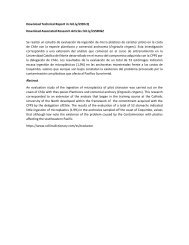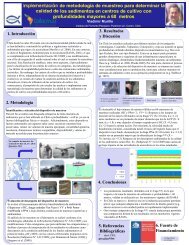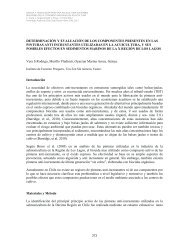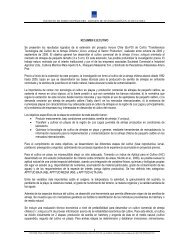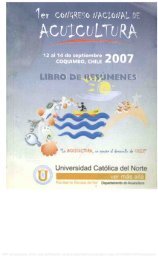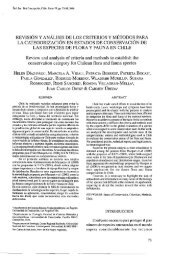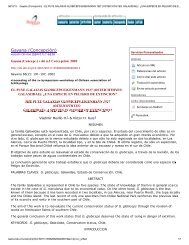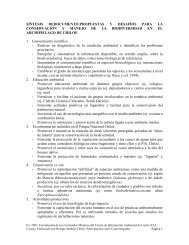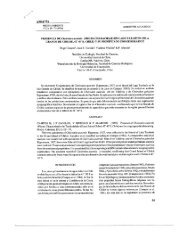Diagnóstico y Proyección de las Actividades de Acuicultura entre Arica y Taltal (in English)
Texto completo disponible en: 1- goo.gl/k5S1g2 2- http://www.fip.cl/FIP/Archivos/pdf/informes/inffinal 2008-34.pdf 3- goo.gl/2XzYv5 (EXECUTIVE SUMMARY) En este proyecto se han integrado distintas aproximaciones con el objeto de desarrollar una herramienta que permita orientar de mejor forma la toma de decisiones en el ámbito de la gestión territorial integrada en el área costera y marina. Entre estas se consigna: el desarrollo de un indice de priorización de especies para su cultivo, la determinación de aptitud de sitios para el desarrollo de actividades productivas, la aplicación de procesos participativos de toma de decisiones, y la proyección y evolución de las áreas disponibles para un desarrollo de actividades de acuicultura en forma sustentable. Entre los principales productos obtenidos se tienen: las especies actualmente cultivadas y su localización geográfica, fichas de las especies con factibilidad de ser cultivadas en entre Arica y Taltal; el establecimiento de la condición ambiental y sanitaria de las áreas de interés; el software DIGAREA para la captura, organización y almacenamiento de la información obtenida de distintas fuentes primarias y su georeferenciación; mapas temáticos estandarizados y normalizados (SIG); el marco regulatorio vigente tanto a nivel nacional como internacional.
Texto completo disponible en:
1- goo.gl/k5S1g2
2- http://www.fip.cl/FIP/Archivos/pdf/informes/inffinal 2008-34.pdf
3- goo.gl/2XzYv5 (EXECUTIVE SUMMARY)
En este proyecto se han integrado distintas aproximaciones con el objeto de desarrollar una herramienta que permita orientar de mejor forma la toma de decisiones en el ámbito de la gestión territorial integrada en el área costera y marina. Entre estas se consigna: el desarrollo de un indice de priorización de especies para su cultivo, la determinación de aptitud de sitios para el desarrollo de actividades productivas, la aplicación de procesos participativos de toma de decisiones, y la proyección y evolución de las áreas disponibles para un desarrollo de actividades de acuicultura en forma sustentable. Entre los principales productos obtenidos se tienen: las especies actualmente cultivadas y su localización geográfica, fichas de las especies con factibilidad de ser cultivadas en entre Arica y Taltal; el establecimiento de la condición ambiental y sanitaria de las áreas de interés; el software DIGAREA para la captura, organización y almacenamiento de la información obtenida de distintas fuentes primarias y su georeferenciación; mapas temáticos estandarizados y normalizados (SIG); el marco regulatorio vigente tanto a nivel nacional como internacional.
You also want an ePaper? Increase the reach of your titles
YUMPU automatically turns print PDFs into web optimized ePapers that Google loves.
I NSTITUTO DE FOMENTO P E S Q UERO / DIVISIÓN INVESTIGACIÓN EN ACUICULTURA<br />
EXECUTIVE SUMMARY<br />
The aim of this study is ‘to diagnose and make projections for aquaculture activities<br />
<strong>in</strong> the North of Chile (<strong>Arica</strong> and Par<strong>in</strong>acota, Tarapacá and Antofagasta regions),<br />
based on the characterization of environmental, sanitary, geographic and<br />
operational conditions.<br />
A diagnosis of the situation at present was ma<strong>de</strong> tak<strong>in</strong>g <strong>in</strong>to consi<strong>de</strong>ration the<br />
major cultivated resources. This <strong>in</strong>volved the gather<strong>in</strong>g of the follow<strong>in</strong>g<br />
antece<strong>de</strong>nts: aquaculture trends, historical production levels, areas where<br />
aquaculture has been concentrated and applied research to diversify the regional<br />
production matrix.<br />
N<strong>in</strong>ety n<strong>in</strong>e aquaculture concessions were i<strong>de</strong>ntified between <strong>Arica</strong> and <strong>Taltal</strong>, of<br />
which 52 were authorized and 47 were <strong>in</strong> the process of be<strong>in</strong>g granted<br />
authorization. These permits cover a total area of 3445.48 ha, across 42 coastal<br />
sites. The historical production basel<strong>in</strong>e along the coast of <strong>Arica</strong> and <strong>Taltal</strong> has<br />
been susta<strong>in</strong>ed by commercial cultures of Chilean scallop, Pacific oyster and<br />
Gracilaria spp. algae. In so far <strong>in</strong> epicont<strong>in</strong>ental waters, commercial cultures have<br />
been susta<strong>in</strong>ed by the microalgae Haematococcus and Spirul<strong>in</strong>a. In addition,<br />
technical-scientific antece<strong>de</strong>nts of cultivation experiments (national and<br />
<strong>in</strong>ternational) were collected for the ma<strong>in</strong> hydrobiological species for which <strong>in</strong>terest<br />
or potential exist for their cultivation. This <strong>in</strong>formation relates to: seed production,<br />
weight ga<strong>in</strong> and optimal cultivation conditions, <strong>in</strong>tensity space utilization, among<br />
other aspects relevant <strong>in</strong> establish<strong>in</strong>g the level of <strong>de</strong>velopment of resource<br />
cultivation. Externalities and limitations were also i<strong>de</strong>ntified associated with<br />
aquaculture <strong>de</strong>velopment. Forty five hydrobiological species were selected with<strong>in</strong><br />
the study area for possible cultivation, of which only 5 are commercially cultured<br />
i<br />
FIP N° 2008-34 - INFORME FINAL: DIAGNÓSTICO Y PROYECCIÓN DE LAS ACTIVIDADES DE ACUICULTURA ENTRE ARICA Y TALTAL
I NSTITUTO DE FOMENTO P E S Q UERO / DIVISIÓN INVESTIGACIÓN EN ACUICULTURA<br />
and 24 experimentally. Sixteen additional species were consi<strong>de</strong>red due to<br />
promis<strong>in</strong>g results <strong>in</strong> commercial or experimental cultures <strong>in</strong> other regions of the<br />
country, and due to good medium-term prospects for <strong>in</strong>dustrial upscal<strong>in</strong>g. In<br />
parallel, scientific and technical literature was collected regard<strong>in</strong>g the possible<br />
environmental effects caused by aquaculture activities <strong>in</strong> Chile and abroad, thus<br />
i<strong>de</strong>ntify<strong>in</strong>g impacts per type of culture (species, culture system) <strong>in</strong> mar<strong>in</strong>e and<br />
freshwater environments. With knowledge of the possible impacts, the most<br />
relevant environmental parameters to aquaculture were <strong>de</strong>term<strong>in</strong>ed, associated<br />
with three physical environmental matrices: seabed, hydrobiological resource and<br />
water column. This step was fundamental <strong>in</strong> evaluat<strong>in</strong>g areas of <strong>in</strong>terest, accord<strong>in</strong>g<br />
to their sanitary and environmental status.<br />
Moreover, an exhaustive analysis of the current environmental legislation <strong>in</strong> Chile<br />
and its application <strong>in</strong> aquaculture <strong>in</strong> the North of the country was carried out.<br />
Regulations and <strong>in</strong>ternational track<strong>in</strong>g programs were also i<strong>de</strong>ntified (e.g., ECASA,<br />
EEA), of which certa<strong>in</strong> procedures could be applied <strong>in</strong> Chile.<br />
Thirty four environmental and sanitary parameters were i<strong>de</strong>ntified for (mar<strong>in</strong>e)<br />
aquaculture <strong>de</strong>velopment accord<strong>in</strong>g to the environmental matrix (sediment,<br />
hydrobiological resource and water). To <strong>de</strong>term<strong>in</strong>e the condition of the sediment,<br />
certa<strong>in</strong> Canadian standards and gui<strong>de</strong>l<strong>in</strong>es for the protection of aquatic life were<br />
<strong>in</strong>clu<strong>de</strong>d: bathymetry, granulometry, organic material load and bottom topography.<br />
In so far as consi<strong>de</strong>red relevant <strong>in</strong> <strong>de</strong>term<strong>in</strong><strong>in</strong>g the sanitary conditions of certa<strong>in</strong><br />
resources with<strong>in</strong> a selected area, the follow<strong>in</strong>g were <strong>in</strong>clu<strong>de</strong>d: heavy metal<br />
concentration (Hg, Cd, Pb and As), the presence of <strong>de</strong>leterious microorganisms for<br />
human health such as Salmonella and paralytic, diarrhetic and amnesic tox<strong>in</strong>s<br />
found <strong>in</strong> seafood. Currentometry parameters, suspen<strong>de</strong>d solids, dissolved oxygen,<br />
temperature, sal<strong>in</strong>ity, chlorophyll-a, pH, heavy metals (Hg, Cd, Pb and As),<br />
hydrogen sulfi<strong>de</strong>, phosphorus, (phosphate–orthophosphate), biological oxygen<br />
ii<br />
FIP N° 2008-34 - INFORME FINAL: DIAGNÓSTICO Y PROYECCIÓN DE LAS ACTIVIDADES DE ACUICULTURA ENTRE ARICA Y TALTAL
I NSTITUTO DE FOMENTO P E S Q UERO / DIVISIÓN INVESTIGACIÓN EN ACUICULTURA<br />
<strong>de</strong>mand, nitrogen, nitrate, total coliforms, fecal coliforms, and pestici<strong>de</strong>s, were all<br />
consi<strong>de</strong>red important variables <strong>in</strong> <strong>de</strong>term<strong>in</strong><strong>in</strong>g the environmental conditions of the<br />
water column.<br />
To counteract the lack of sanitary and environmental <strong>in</strong>formation for the study area,<br />
complementary sampl<strong>in</strong>g was done <strong>in</strong> the follow<strong>in</strong>g selected areas: Playa<br />
Corazones (south of <strong>Arica</strong>), Caleta Camarones, Bahía <strong>de</strong> Pisagua, Caleta Los<br />
Ver<strong>de</strong>s, Caleta Chanavayita, Caleta Chipana, Caleta Punta Arenas, Caleta<br />
Constitución, Caleta Paposo and Caleta Buena (south of <strong>Taltal</strong>). These localities<br />
were selected us<strong>in</strong>g a graphical analysis which allowed the <strong>de</strong>limitation of<br />
homogenous areas and the discard<strong>in</strong>g of areas where economic activities are<br />
<strong>in</strong>compatible with small scale aquaculture or provoke <strong>de</strong>leterious environmental<br />
impacts.<br />
With respect to the relevant parameters for public health, the follow<strong>in</strong>g were limit<strong>in</strong>g <strong>in</strong><br />
the commercialization of aquaculture products: mar<strong>in</strong>e mollusks obta<strong>in</strong>ed <strong>in</strong> situ<br />
excee<strong>de</strong>d maximum levels of arsenic (2.0 mg/kg), for two thirds of the stations south<br />
of Bahía <strong>de</strong> Pisagua and at the three sampl<strong>in</strong>g stations <strong>in</strong> Caleta Chanavayita. With<br />
regards to lead, only a third of the sampl<strong>in</strong>g stations <strong>in</strong> Caleta Chanavayita registered<br />
mollusks that excee<strong>de</strong>d the maximum (1.5 mg/kg). No sampl<strong>in</strong>g stations excee<strong>de</strong>d<br />
the maximum for mercury (0.50 mg/kg), <strong>in</strong> contrast with cadmium where all sampled<br />
stations excee<strong>de</strong>d the maximum (1.0 mg/kg).<br />
Based on the results obta<strong>in</strong>ed from complimentary sampl<strong>in</strong>g, we conclu<strong>de</strong> that the<br />
best sites for aquaculture <strong>de</strong>velopment <strong>in</strong> geophysical and environmental-sanitary<br />
terms are: Caleta Corazones, Caleta Chanavayita, Caleta Punta Arenas, Caleta<br />
Constitución and Caleta Buena. The restrictive limitation is the high levels of<br />
cadmium that exceed the maximum.<br />
iii<br />
FIP N° 2008-34 - INFORME FINAL: DIAGNÓSTICO Y PROYECCIÓN DE LAS ACTIVIDADES DE ACUICULTURA ENTRE ARICA Y TALTAL
I NSTITUTO DE FOMENTO P E S Q UERO / DIVISIÓN INVESTIGACIÓN EN ACUICULTURA<br />
Along the coast of the northern regions of Chile, (<strong>Arica</strong> and Par<strong>in</strong>acota, Tarapacá<br />
and Antofagasta), there are 70 coastal polygons <strong>de</strong>scribed <strong>in</strong> legal <strong>de</strong>crees as<br />
Suitable Areas for Aquaculture activities (A.A.A). These polygons are distributed<br />
between 41 sites, cover<strong>in</strong>g a total area of 32,129.91 ha. Nevertheless, <strong>de</strong>spite the<br />
available area, there is clear un<strong>de</strong>rutilization of these areas, such that <strong>in</strong> 47 of<br />
these coastal polygons there are no aquaculture concessions or concession<br />
requests. Furthermore, there are issues regard<strong>in</strong>g the overlap with AMERBs<br />
(Areas of Management and Exploitation of Benthic Resources). In function of<br />
coastal dynamics, 27 bay systems were i<strong>de</strong>ntified <strong>in</strong> the study area.<br />
All the environmental <strong>in</strong>formation collected was plotted with Geographical<br />
Information System (GIS), produc<strong>in</strong>g standardized and normalized thematic maps,<br />
as well as <strong>de</strong>term<strong>in</strong><strong>in</strong>g variables and/or parameters which can be consi<strong>de</strong>red<br />
operationally suitable <strong>in</strong> <strong>de</strong>signat<strong>in</strong>g “suitable areas for aquaculture”, with a focus<br />
on improved space utilization and the susta<strong>in</strong>ability of this economic activity.<br />
In or<strong>de</strong>r to <strong>de</strong>term<strong>in</strong>e the species of “<strong>in</strong>terest for aquaculture” an <strong>in</strong><strong>de</strong>x was <strong>de</strong>veloped<br />
(IPEA: In<strong>de</strong>x for Species Prioritization <strong>in</strong> Aquaculture) given the lack of this k<strong>in</strong>d of<br />
tool. This procedure c<strong>las</strong>sified 14 species as “priority species” and 20 species as “non<br />
priority species” or “not for immediate consi<strong>de</strong>ration”, based on bioproductive,<br />
technological and economic consi<strong>de</strong>rations. Species with<strong>in</strong> the first group were the<br />
follow<strong>in</strong>g: Chilean scallop (Argopecten purpurata), Pacific oyster (Crassostrea gigas),<br />
Chilean oyster (Tiostrea chilensis), red abalone (Haliotis rufescens), Chilean abalone<br />
(Concholepas concholepas), octopus (Octopus mimus), South American freshwater<br />
shrimp (Cryphiops caementarius), hairy marron crayfish (Cherax tenuimanus), Chilean<br />
halfmoon (Medialuna ancietae), yellowtail amberjack (Seriola lalandi), tuna (Thunnus<br />
spp.), Japanese sea cucumber (Apostichopus japonicus), giant kelp (Lessonia<br />
nigrescens) and Gracilaria spp. algae. Thereafter, geographical areas of <strong>in</strong>terest and<br />
priority species were matched, generat<strong>in</strong>g cultivation capabilities by sector. Results<br />
iv<br />
FIP N° 2008-34 - INFORME FINAL: DIAGNÓSTICO Y PROYECCIÓN DE LAS ACTIVIDADES DE ACUICULTURA ENTRE ARICA Y TALTAL
I NSTITUTO DE FOMENTO P E S Q UERO / DIVISIÓN INVESTIGACIÓN EN ACUICULTURA<br />
from a numerical procedure <strong>in</strong>dicate that: Cerro Moreno-Isla Santa Maria, Ñajo-<br />
Pabellón <strong>de</strong> Pica, Caleta San Marcos-Playa Corazones, Tocopilla-Río Loa and <strong>Taltal</strong>-<br />
Paposo are the areas where the best conditions are concentrated (High Potential) for<br />
the <strong>de</strong>velopment of aquaculture, allow<strong>in</strong>g the cultivation of 6 to 12 of the total of<br />
evaluated species <strong>in</strong> this analysis. Those species with the highest suitability across<br />
study areas were (<strong>in</strong> <strong>de</strong>creas<strong>in</strong>g or<strong>de</strong>r): Gracilaria spp., Chilean scallop, giant kelp,<br />
Chilean oyster and red abalone, whose spatial coverage spans at least 7 areas. Punta<br />
Camarones-Caleta Chica, Tiviliche–Pisagua, Chipana and Playa Folkers-Lobitos only<br />
scored <strong>in</strong>termediate conditions <strong>in</strong> the diversification matrix, allow<strong>in</strong>g for the cultivation<br />
of 2 to 4 species. Most of the biological requirements for the Japanese oyster,<br />
octopus, Chilean abalone, Peruvian halfmoon and the Japanese sea cucumber were<br />
not present <strong>in</strong> the areas evaluated, thus these species are spatially limited to areas<br />
where production is possible but with certa<strong>in</strong> restrictions (Medium Potential). In the<br />
case of amberjack and tuna, both species presented Low Potential <strong>in</strong> the Playa<br />
Folkers - Lobito sector which makes their cultivation unsuitable <strong>in</strong> this coastal area,<br />
(Table 1.43). The same premises should be followed for other areas where medium<br />
potential was i<strong>de</strong>ntified, except Cerro Moreno-Isla Santa María where potential was<br />
high.<br />
The procedures outl<strong>in</strong>ed <strong>in</strong> this study are focused on better spatial utilization and<br />
susta<strong>in</strong>ability of resource cultivation, represent<strong>in</strong>g a tool that allows better orientation<br />
for <strong>de</strong>cision mak<strong>in</strong>g <strong>in</strong> <strong>in</strong>tegrated spatial management <strong>in</strong> aquaculture. This can be<br />
used for spatial plann<strong>in</strong>g of resource use, locat<strong>in</strong>g areas of potential, zonification of<br />
areas with previously <strong>de</strong>f<strong>in</strong>ed limits (geographically and politico-adm<strong>in</strong>istratively) and<br />
compar<strong>in</strong>g the productive and environmental value of different zones, among other<br />
applications <strong>in</strong> conserv<strong>in</strong>g a national resource of public use.<br />
To quantify the evolution or <strong>de</strong>velopment of the aquaculture sector, a track<strong>in</strong>g<br />
system was employed which <strong>in</strong>corporates geographical factors, resource<br />
v<br />
FIP N° 2008-34 - INFORME FINAL: DIAGNÓSTICO Y PROYECCIÓN DE LAS ACTIVIDADES DE ACUICULTURA ENTRE ARICA Y TALTAL
I NSTITUTO DE FOMENTO P E S Q UERO / DIVISIÓN INVESTIGACIÓN EN ACUICULTURA<br />
characteristics and the human context <strong>in</strong> which the activity is be<strong>in</strong>g <strong>de</strong>veloped.<br />
With this <strong>in</strong> m<strong>in</strong>d and <strong>in</strong> or<strong>de</strong>r to support the digital organization and storage of<br />
data, the DigAreas.exe program was <strong>de</strong>veloped. This tool enables data of the<br />
specific area of <strong>in</strong>terest (AAA, MPA, AMERB, etc.), to form a non-limited group<strong>in</strong>g<br />
of coord<strong>in</strong>ate pairs <strong>in</strong> Lat-Lon or UTM format, <strong>in</strong>dicat<strong>in</strong>g datum and l<strong>in</strong>k<strong>in</strong>g samples<br />
to data. The data from samples covered the follow<strong>in</strong>g areas: Sediment, Water,<br />
Macrofauna and Resources.<br />
F<strong>in</strong>ally, it is important to po<strong>in</strong>t out that the experience of IFOP <strong>in</strong> these k<strong>in</strong>ds of<br />
projects <strong>in</strong>dicates that the early <strong>in</strong>volvement of <strong>in</strong>terest groups leads to result<br />
validation, facilitates reach<strong>in</strong>g a consensus and reduces subsequent conflicts.<br />
Thus, with the aim of achiev<strong>in</strong>g high levels of participation, this project <strong>in</strong>clu<strong>de</strong>d<br />
participative methodology which among others, consisted <strong>in</strong> workshops for the<br />
diffusion and discussion of results <strong>in</strong> the three relevant regions. Also, an<br />
<strong>in</strong>formative blog was set up which is constantly be<strong>in</strong>g updated,<br />
http://proyectofip2008-34.blogspot.com. Additionally, an image gallery was created<br />
via a social network<strong>in</strong>g site, http://www.flickr.com/photos/proyectofip2008-34/.<br />
Mayor <strong>in</strong>formación disponible:<br />
https://www.aca<strong>de</strong>mia.edu/4713776/IF_N_2008-34_Diagn<br />
%C3%B3stico_y_Proyecci<br />
%C3%B3n_<strong>de</strong>_<strong>las</strong>_Activida<strong>de</strong>s_<strong>de</strong>_<strong>Acuicultura</strong>_<strong>entre</strong>_<strong>Arica</strong>_y_<strong>Taltal</strong><br />
http://www.fip.cl/FIP/Archivos/pdf/<strong>in</strong>formes/<strong>in</strong>ff<strong>in</strong>al%202008-34.pdf<br />
vi<br />
FIP N° 2008-34 - INFORME FINAL: DIAGNÓSTICO Y PROYECCIÓN DE LAS ACTIVIDADES DE ACUICULTURA ENTRE ARICA Y TALTAL
INSTITUTO DE FOMENTO PESQUERO<br />
Sección Ediciones y Producción<br />
Blanco 839, Fono 56-32-2151500<br />
Valparaíso, Chile<br />
www.ifop.cl




